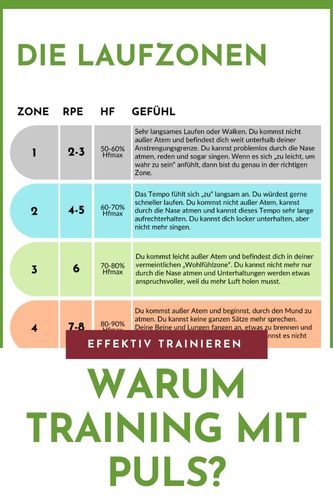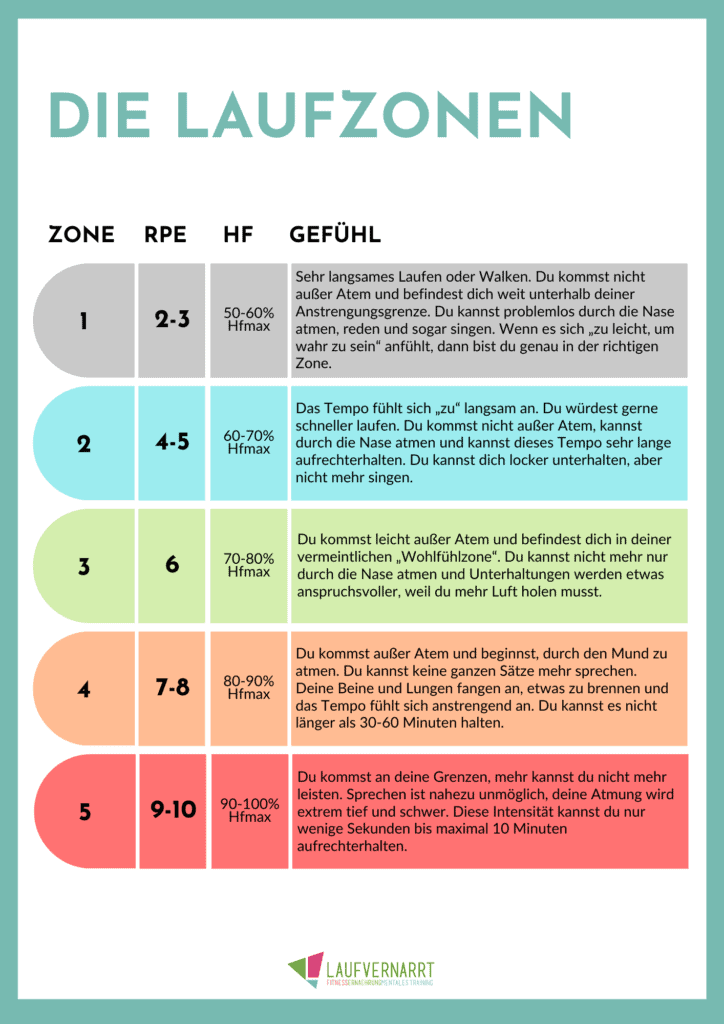Jogging at heart rate has numerous benefits. But which ones? Heart rate while jogging is actually the right one and how can you determine it? With this blog article I would like to give you an introduction to heart rate-based training and tell you everything about the right heart rate when jogging. You will know:
- Why jogging at heart rate?
- How do I determine the correct heart rate when jogging?
- Running zones 1×1 – which pulse for which goal?

Why jogging at heart rate?
Do you want to train effectively?
Then you can’t just limit yourself to jogging harder, longer or more often. That won’t get you to your goal in the long term. Because it’s also about training smarter.
We measure effective training not only by frequency and duration, but also by a third variable: intensity.
- Frequency simply describes how often your training takes place.
- Duration is about the length of your jogging session.
- And the intensity tells you how stressful a training session is for you.
While the duration and frequency are absolutely objective values, in everyday life we often lack guidance for the right intensity. Of course, you can also simply jog based on how you feel or choose a target time that you want to run. But both can sometimes become very inaccurate.
Heart rate offers a very precise and up-to-date way to determine your fitness and control your training intensity. In this way, the intensity can be represented by a measurable and objective number.
Because your heart rate shows you how many times per minute your heart beats to maintain the strain.
Through the use of the Heart rate while jogging we can check whether we are training at the right level. This makes it easier to assess how much you are benefiting from your running training and also how much rest and recovery your body needs before the next workout.
The right mix of stress and recovery is incredibly important. Because we only get better during breaks. In addition, the risk of injury is minimized and motivation is increased in the long term.
Measuring your heart rate while jogging gives you security and allows you to react quickly to over- or under-exertion during your run or workout. This means that every minute of pulse-controlled training contributes towards your sporting goals.


What heart rate when jogging?
But which heart rate is the right one when jogging?
In principle, it is not possible to specify absolute heart rate values at which every person should complete every run. On the contrary: which heart rate is suitable for jogging depends on your maximum pulse and the respective training goal of the individual session.
The maximum heart rate is a very individual value that is different for every person. This value is the maximum possible number of beats per minute for your heart at the highest load.
If we now want to determine the optimal heart rate when jogging, we first need our maximum pulse.
Determine maximum pulse – what heart rate when jogging?
You can determine your maximum heart rate either under laboratory conditions or in a self-test.
There are also formulas for calculating the maximum pulse, but these are extremely inaccurate. Fluctuations of up to 30-50 beats can easily occur. Such inaccurate values are obsolete for training control. That’s why I advise against these formulas.
The most accurate option is to determine your heart rate in the laboratory under the supervision of a sports medicine specialist. The exact training areas are also determined directly.
But since this procedure is quite complex and expensive, you can alternatively use a self-test to determine an approximate value with a few strokes of inaccuracy.


This is how the self-test works
So that you can find out which heart rate is right for you when jogging, start with a self-test to determine your maximum pulse. Keep in mind that this test is extremely stressful. It should only be completed if you already have a certain level of basic fitness, are in good health and have been able to recover well before the self-test.
And this is how it works:
- Warm up for ten minutes. To do this, run at a slow pace.
- Now complete three intervals with a two-minute trot break in between. In the first interval you run at a faster pace, but it doesn’t make you very out of breath. In the second round you increase your pace so much that you get slightly out of breath. And in the third round you push yourself to your absolute limit. You increase the pace to the point where you can no longer run any faster, your breathing becomes very difficult and your lungs and legs start to burn.
- Immediately afterwards, warm down for at least ten minutes. To do this, run at a slow pace and keep moving immediately after the fastest interval.
The highest measured value corresponds somewhat to your maximum heart rate. You may be able to add a few more beats here, but normally there should be no greater inaccuracy than 2-5 beats. Based on this value, you can now determine which heart rate is suitable for you when jogging.


What heart rate when jogging? – Running zones 1×1
You now know your maximum heart rate. But a second building block for the right heart rate when jogging are the training areas in which you do your running training.
Depending on the goal of your run, we train in different heart rate zones. These zones are each given as a percentage of the maximum heart rate. There are a total of five different running zones, which you will get to know in detail right away.
Basically, with a sensible running training plan, we spend a lot of time in the second zone. This area should account for approximately 80-95% of your training sessions. The fourth and fifth zones complement the training for targeted endurance runs and interval training.
If you save this knowledge for yourself, you can take a lot with you for your own training and in the future answer the question: “What heart rate when jogging?” correctly. This way you get more out of your runs and become more stamina, fitter and more resilient.
Running zone table
| Zone | RPE | heart rate | Training goal |
| 1 | 2-3 | 50-60% HR max | Training in the first zone promotes recovery and health. Therefore, it is a good preparation for units in higher stress zones and to improve recovery. For beginners, this can already be a training zone for building basic endurance. |
| 2 | 4-5 | 60-70% HR max | In the second zone, general endurance improves. The classic basic endurance training takes place here, which should make up around 80-95% of your running units. This training optimizes fat metabolism and muscular fitness. Due to the low intensity, the training is hardly stressful and promotes regeneration. |
| 3 | 6 | 70-80% HR max | Training in the third zone approaches the anaerobic threshold, making it more stressful. Most runners intuitively feel most comfortable in this zone, although it is a little too fast for basic endurance training and too slow for speed training. |
| 4 | 7-8 | 80-90% HR max | Completing the units at this intensity improves speed endurance and stamina at higher speeds. Now the body can better use carbohydrates as an energy source. The ability to tolerate the higher lactate levels in the blood is also improved. Training sessions in this zone tend to be short and hard. |
| 5 | 9-10 | >90% HR max | It is the maximum effort. The cardiovascular system is now working at maximum capacity. There is an increase and accumulation of lactate in the blood. Training in this zone is, compared to the other zones, only possible for a short period of time of a few minutes.
At the beginning of the sport, you shouldn’t give this zone too much space. Things look different for ambitious athletes and professional athletes. You should plan units with high intensities into your repertoire. If you neglect these areas, it will be difficult to improve performance in the long term. |


Training heart rate and resting heart rate – What does your resting heart rate reveal?
In addition to the maximum pulse, there is another heart rate value that can be very informative for your own fitness. This is the resting heart rate.
Your resting heart rate can give you information about your daily form. The resting heart rate is the number of damages per minute that your heart needs to keep your body alive at complete rest. Typically, your resting heart rate is lowest in the early morning hours while you are still sleeping.
If your resting heart rate is elevated, this indicates a high level of stress. You may then be struggling with an infection that is starting or fading away. Maybe your last few training sessions were very hard. Or you are suffering from intense psychological or emotional stress. All of these can increase your resting heart rate, indicating that it may be appropriate to adjust or postpone your workout.
In the long term, your resting heart rate will change as you increase your fitness. As you become more stamina and fitter, your resting heart rate will gradually decrease. This is a very good sign!
A healthy resting heart rate is between 60-80 beats per minute. For athletes it can also drop to the range of 40-50 bpm (beats per minute).
Conclusion – what heart rate when jogging?
Measuring your heart rate while jogging helps you train more effectively and efficiently in the long term, maintain your motivation and overwork yourself less.
The correct heart rate when jogging is individual and depends on your maximum pulse. The best way to determine your maximum pulse is in a laboratory or through a self-test. You can use it to determine your training heart rate for your runs. To do this, you focus on the different running zones and calculate them individually for yourself.


